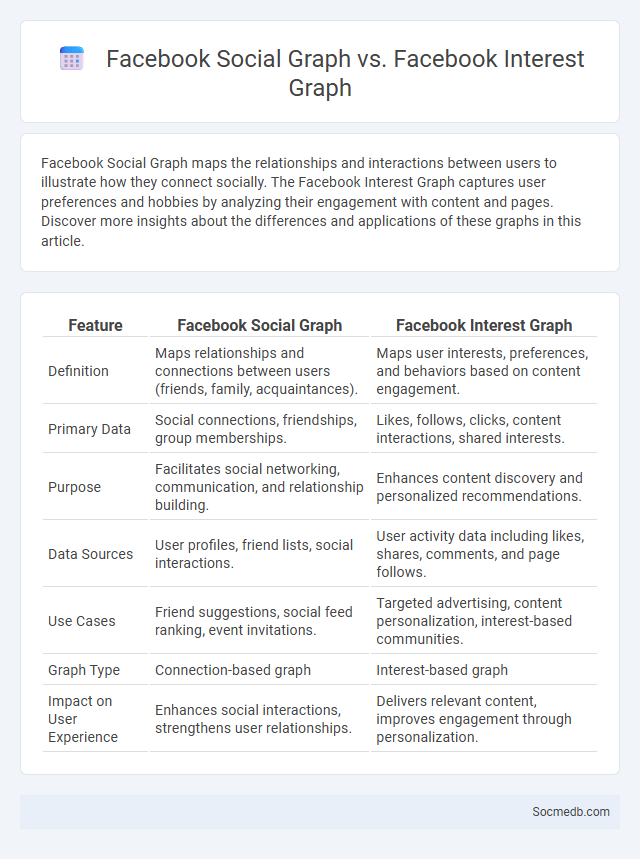
Photo illustration: Facebook Social Graph vs Facebook Interest Graph
Facebook Social Graph maps the relationships and interactions between users to illustrate how they connect socially. The Facebook Interest Graph captures user preferences and hobbies by analyzing their engagement with content and pages. Discover more insights about the differences and applications of these graphs in this article.
Table of Comparison
| Feature | Facebook Social Graph | Facebook Interest Graph |
|---|---|---|
| Definition | Maps relationships and connections between users (friends, family, acquaintances). | Maps user interests, preferences, and behaviors based on content engagement. |
| Primary Data | Social connections, friendships, group memberships. | Likes, follows, clicks, content interactions, shared interests. |
| Purpose | Facilitates social networking, communication, and relationship building. | Enhances content discovery and personalized recommendations. |
| Data Sources | User profiles, friend lists, social interactions. | User activity data including likes, shares, comments, and page follows. |
| Use Cases | Friend suggestions, social feed ranking, event invitations. | Targeted advertising, content personalization, interest-based communities. |
| Graph Type | Connection-based graph | Interest-based graph |
| Impact on User Experience | Enhances social interactions, strengthens user relationships. | Delivers relevant content, improves engagement through personalization. |
Understanding Social Graph: Definition and Importance
Understanding the social graph is crucial for optimizing social media strategies, as it maps relationships and interactions between users, enabling deeper insights into behavior patterns and influence networks. Your ability to analyze the social graph helps identify key influencers, target audiences, and community clusters, enhancing engagement and content relevance. Leveraging this data improves personalized communication, drives viral marketing campaigns, and boosts social media performance.
What Is Facebook’s Social Graph?
Facebook's Social Graph is a digital representation of the connections and relationships between users, their interests, and interactions on the platform. It maps friendships, likes, shares, comments, and affiliations to create a comprehensive network of social data. This graph enables personalized content delivery, targeted advertising, and enhanced user engagement by understanding how individuals are interconnected.
Exploring Facebook’s Interest Graph
Facebook's Interest Graph maps your likes, activities, and connections to deliver highly personalized content and ads tailored to your preferences. By analyzing interactions across pages, groups, and posts, it enables precise targeting for marketers seeking deeper audience insights. Leveraging this data enhances engagement and optimizes your social media experience, fostering relevant connections and content discovery.
Social Graph vs. Interest Graph: Core Differences
The Social Graph maps connections between individuals based on relationships like friends, family, or colleagues, emphasizing who people know. The Interest Graph centers on users' preferences, hobbies, and behaviors, linking individuals through shared interests regardless of direct social connections. Understanding these distinctions helps platforms tailor content recommendations and advertising strategies to either relational networks or interest-based communities.
How Facebook Utilizes the Social Graph
Facebook utilizes the Social Graph to map and analyze user relationships, interactions, and shared content across its platform. By leveraging this interconnected data, Facebook personalizes news feeds, enhances ad targeting, and improves friend recommendations. The Social Graph's comprehensive model of social connections drives user engagement and platform growth by fostering relevant and meaningful interactions.
Interest Graph: Mapping User Preferences on Facebook
Facebook's Interest Graph analyzes user interactions, likes, and shares to create a detailed map of Your preferences, enabling precise content recommendations and targeted advertising. This technology leverages semantic data to connect users with topics and communities that align closely with their interests. By understanding the relationships between various interests, Facebook enhances user engagement and personalizes the social media experience effectively.
Comparing Data Sources: Social Graph vs. Interest Graph
The Social Graph maps relationships between individuals based on their real-world connections, while the Interest Graph centers on shared passions, activities, and preferences among users. Your marketing strategy benefits from leveraging the Social Graph to target networks of friends or colleagues, whereas the Interest Graph enables precise content discovery tailored to specific hobbies or interests. Understanding the distinctions between these data sources enhances engagement by aligning messaging with either social ties or user-driven interests.
Impact on Content Personalization and Recommendations
Social media platforms leverage advanced algorithms and machine learning techniques to analyze user behavior, preferences, and interactions, driving highly personalized content feeds and tailored recommendations. This data-driven approach enhances user engagement by continuously adapting content based on individual interests and real-time activity, improving relevance and user satisfaction. Effective content personalization increases the visibility of targeted ads and suggested connections, optimizing both user experience and platform monetization.
Privacy Concerns in Social and Interest Graphs
Social media platforms collect vast amounts of user data to build detailed social and interest graphs, raising significant privacy concerns. Unauthorized access or misuse of this data can lead to identity theft, targeted manipulation, and erosion of user trust. Implementing robust encryption and transparent data policies is critical to protecting user privacy in these interconnected digital environments.
Future Trends: Evolving Roles of Social and Interest Graphs
Social and interest graphs are redefining the landscape of social media by enabling more personalized and context-aware user experiences, driving deeper engagement and stronger community bonds. Advances in AI and machine learning will enhance the accuracy and relevance of these graphs, allowing platforms to predict user behavior and interests with greater precision. Your social media interactions will become increasingly tailored, fostering meaningful connections and content discovery based on complex relationship and interest mapping.
 socmedb.com
socmedb.com